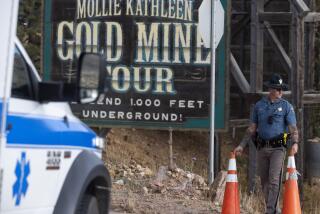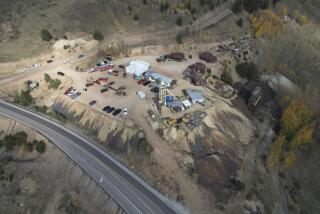Some Miners’ Air Packs Were Faulty, Survivor Says
- Share via
BUCKHANNON, W.Va. — Trapped deep below ground by poisonous gases, the Sago miners realized at least four of their air packs did not work, and they were forced to share the devices as they desperately pounded away with a sledgehammer in hopes of getting rescuers’ attention, the sole survivor says.
Finally, resigned to their fate, the men recited a “sinner’s prayer,” scrawled farewell notes to their loved ones, and succumbed, some as if drifting off to sleep.
“As my trapped co-workers lost consciousness one by one, the room grew still and I continued to sit and wait, unable to do much else,” Randal McCloy Jr. wrote to his co-workers’ families in a letter dated Wednesday and obtained by the Associated Press.
McCloy’s 2 1/2 -page typed letter offered the most detailed account yet of what happened in the Sago mine after the Jan. 2 explosion. The blast killed one miner and spread carbon monoxide that slowly asphyxiated 11 other men 260 feet below ground as they waited in the farthest reaches of the mine to be rescued.
The air packs -- referred to in the letter as “rescuers” -- are intended to give each miner about an hour’s worth of oxygen while they escape or find a pocket of clean air. But at least four of the devices did not function, McCloy said.
“There were not enough rescuers to go around,” McCloy said. He said he shared his air pack with miner Jerry Groves, and his co-workers did the same with the three other men whose devices were not functioning.
In a statement, mine owner International Coal Group Inc. said that federal investigators tested the miners’ air packs -- also known as self-contained self-rescue devices, or SCSRs -- and found no evidence that any of them had malfunctioned.
Dirk Fillpot, a spokesman with the federal Mine Safety and Health Administration, confirmed that the agency and the National Institute for Occupational Safety and Health examined all the air packs recovered from the mine after the explosion, and said initial tests found that the devices that had been activated would have functioned properly.
The mine safety agency “is looking at whether the miners received adequate training in the use of their SCSRs,” Fillpot said in a statement.
After the blast, the miners returned to their rail car in hopes of escaping along the track, but had to abandon their efforts because of bad air. They then retreated, hung a curtain to keep out the poisonous gases, and tried to signal their location by beating on the mine bolts and plates.
“We found a sledgehammer, and for a long time, we took turns pounding away,” McCloy wrote. “We had to take off the rescuers in order to hammer as hard as we could. This effort caused us to breathe much harder. We never heard a responsive blast or shot from the surface.”
More to Read
Sign up for Essential California
The most important California stories and recommendations in your inbox every morning.
You may occasionally receive promotional content from the Los Angeles Times.













